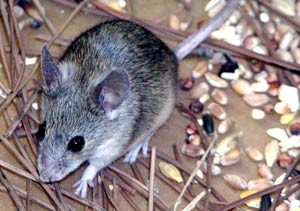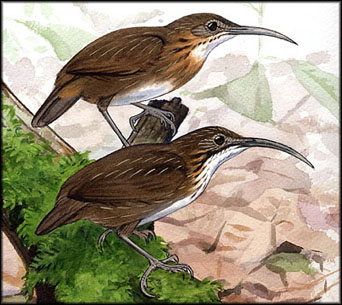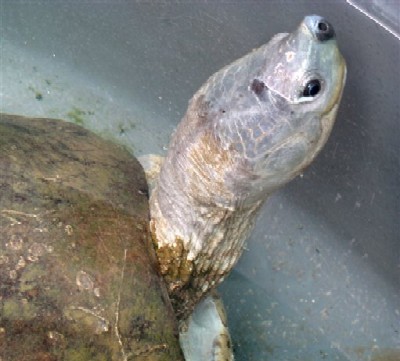
January 21, 2007

This is the latest new mammal discovered in Europe, Mus cypriacus or the Cypriot mouse, which was described last year in the journal Zootaxa.
How does one determine that a new species has been discovered? How is it that one location has one species of salamander and thirty years later there are said to be many new species in that area? From where do all the new species come?

The Naung Mung Scimitar-Babbler (Jabouilleia naungmungensis) was discovered in the pre-montane rainforests of northern Myanmar (Burma) in 2005. Their discovery, however, was not announced until 2006. It is a unique new species. The painting directly above of this bird is from the cover of The Auk.
Cryptozoology is the study of hidden, as yet undiscovered new animals, new species, and re-discovered reportedly extinct species. Of course, if the animal is a rediscovery, the species is already known, but needs to be confirmed. Some of what is happening with regard to the brand new discoveries is exploring new habitats, acknowledging the reality of ethnoknown (native realized) new animals, and finding new species by sight. Another part of what is occurring with new species discoveries is taking place on the molecular level of, for example, DNA findings. Both approaches are valid. Both are instructive.

The mangrove terrapin (Batagur baska) of Thailand (above) was recently rediscovered after being thought extinct for the last two decades.
Whit Gibbons is a professor of zoology and senior biologist at the University of Georgia, and addresses many of the elementary but complex questions about new species in an editorial published today, I must note, hidden away in The Tuscaloosa News. Following are the article’s contributions, specifically, on the subject of new species, illustrated with photos from the past pages of Cryptomundo of the many kinds of new species:
The first step in discovering a new species is knowing which species have already been discovered. When ecologists travel to regions where they are not familiar with the plants and animals, they read field guides about the flora and fauna. Many of these guides have photographs, keys to species recognition and descriptions of size, color and general appearance. Ideally, the books also have information about geographic ranges and the ecology of species. Examining museum specimens to learn about variations among species in a taxonomic group is important, too.

A close relative of the sucker-footed bat shown here has been recently discovered, but it is so new there are no photographs generally published of it yet.
To recognize that a species is new, you must be an expert in a particular taxonomic group. The most likely areas for new species discoveries are exotic, unpopulated regions, especially in the tropics. For example, within recent months a new species of bat was found in Madagascar, a new monkey in Tanzania and a new plant (in the violet family) in Cameroon. The scientists describing the new species had to be familiar with the particular taxonomic group and know the characteristics of every known species in the world.
New species, particularly insects, continue to be discovered even in North America, but the numbers pale in comparison to tropical regions. Because most of the United States and western Europe have been surveyed extensively, truly new species of vertebrates are less likely to be discovered. However, the use of DNA and other genetic analyses has brought greater definition to the relationships among species, so a plant or animal once thought to be a single species may be redefined as two or more.
For example, a map in a U.S. field guide from the 1970s will show a single species of the slimy salamander (Plethodon glutinosus) occupying most of the eastern United States. Today, slimy salamanders are partitioned into 16 different species, with different ones occupying different parts of the former range, based on a gene identification technique known as electrophoresis. Although most of the “new” species cannot be distinguished from each other visually, they are genetically distinctive. These kinds of species descriptions, however, do not count as discoveries never before seen by humans.
A different use of genetic analyses “to discover a new species” can be found in the 2003 description of Chamberlain’s dwarf salamander from the Carolinas. These tiny brownish creatures are distinguishable from most other salamanders by their small size and by having four toes on each hind foot instead of five. Since at least the 1980s, the dwarf salamander has been known by herpetologists to represent two distinct species, because one has a bright yellow belly. However, no one had formally described them in a scientific journal using the “International Code of Zoological Nomenclature.” The 2003 description used genetic evidence along with morphological traits to distinguish two species that were already known to be distinct.
Genetic analyses were also used this past year to confirm the discovery of a new species of lizard in the rainforests of Borneo. In this case, the scientists were not splitting an assumed single species into separate genetic units or giving official recognition to a species already recognized as having two distinct forms. This was a species of lizard never before seen by scientists. They used DNA analyses to determine who its closest lizard relative is, which turns out to be a distantly related lizard from the Philippines.
Species new to science will continue to be found as long as scientists look for them. But we must guard against the misconception that such species are new to the world. They are not. They have been here for millions of years. And it is up to us to ensure that both “old” and “new” species remain a part of our environment.
Source: Whit Gibbons, “New discoveries of species is rare but still occurs” The Tuscaloosa News, January 21, 2007.

Reader beware: Some species, like the Jackson’s mongoose pictured above, are merely “new” to a country, as per the recent sightings of it in Tanzania, not “new” in any other sense.
About Loren Coleman
Loren Coleman is one of the world’s leading cryptozoologists, some say “the” leading living cryptozoologist. Certainly, he is acknowledged as the current living American researcher and writer who has most popularized cryptozoology in the late 20th and early 21st centuries.
Starting his fieldwork and investigations in 1960, after traveling and trekking extensively in pursuit of cryptozoological mysteries, Coleman began writing to share his experiences in 1969. An honorary member of Ivan T. Sanderson’s Society for the Investigation of the Unexplained in the 1970s, Coleman has been bestowed with similar honorary memberships of the North Idaho College Cryptozoology Club in 1983, and in subsequent years, that of the British Columbia Scientific Cryptozoology Club, CryptoSafari International, and other international organizations. He was also a Life Member and Benefactor of the International Society of Cryptozoology (now-defunct).
Loren Coleman’s daily blog, as a member of the Cryptomundo Team, served as an ongoing avenue of communication for the ever-growing body of cryptozoo news from 2005 through 2013. He returned as an infrequent contributor beginning Halloween week of 2015.
Coleman is the founder in 2003, and current director of the International Cryptozoology Museum in Portland, Maine.
Filed under Breaking News, Cryptomundo Exclusive, CryptoZoo News, Cryptozoologists, Cryptozoology, Evidence, Expedition Reports, Extinct, Eyewitness Accounts, Forensic Science, New Species, Out of Place